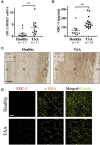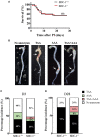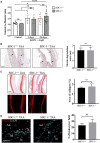Syndecan-1 Is Overexpressed in Human Thoracic Aneurysm but Is Dispensable for the Disease Progression in a Mouse Model
- PMID: 35548440
- PMCID: PMC9082175
- DOI: 10.3389/fcvm.2022.839743
Syndecan-1 Is Overexpressed in Human Thoracic Aneurysm but Is Dispensable for the Disease Progression in a Mouse Model
Abstract
Glycosaminoglycans (GAGs) pooling has long been considered as one of the histopathological characteristics defining thoracic aortic aneurysm (TAA) together with smooth muscle cells (SMCs) apoptosis and elastin fibers degradation. However, little information is known about GAGs composition or their potential implication in TAA pathology. Syndecan-1 (SDC-1) is a heparan sulfate proteoglycan that is implicated in extracellular matrix (ECM) interaction and assembly, regulation of SMCs phenotype, and various aspects of inflammation in the vascular wall. Therefore, the aim of this study was to determine whether SDC-1 expression was regulated in human TAA and to analyze its role in a mouse model of this disease. In the current work, the regulation of SDC-1 was examined in human biopsies by RT-qPCR, ELISA, and immunohistochemistry. In addition, the role of SDC-1 was evaluated in descending TAA in vivo using a mouse model combining both aortic wall weakening and hypertension. Our results showed that both SDC-1 mRNA and protein are overexpressed in the media layer of human TAA specimens. RT-qPCR experiments revealed a 3.6-fold overexpression of SDC-1 mRNA (p = 0.0024) and ELISA assays showed that SDC-1 protein was increased 2.3 times in TAA samples compared with healthy counterparts (221 ± 24 vs. 96 ± 33 pg/mg of tissue, respectively, p = 0.0012). Immunofluorescence imaging provided evidence that SMCs are the major cell type expressing SDC-1 in TAA media. Similarly, in the mouse model used, SDC-1 expression was increased in TAA specimens compared to healthy samples. Although its protective role against abdominal aneurysm has been reported, we observed that SDC-1 was dispensable for TAA prevalence or rupture. In addition, SDC-1 deficiency did not alter the extent of aortic wall dilatation, elastin degradation, collagen deposition, or leukocyte recruitment in our TAA model. These findings suggest that SDC-1 could be a biomarker revealing TAA pathology. Future investigations could uncover the underlying mechanisms leading to regulation of SDC-1 expression in TAA.
Keywords: Syndecan-1; aneurysm; extracellular matrix; proteoglycan; smooth muscle cell (SMC).
Copyright © 2022 Zalghout, Vo, Arocas, Jadoui, Hamade, Badran, Oudar, Charnaux, Longrois, Boulaftali, Bouton and Richard.
Conflict of interest statement
The authors declare that the research was conducted in the absence of any commercial or financial relationships that could be construed as a potential conflict of interest.
Figures




References
-
- Halushka MK, Angelini A, Bartoloni G, Basso C, Batoroeva L, Bruneval P, et al. . Consensus statement on surgical pathology of the aorta from the Society for Cardiovascular Pathology and the Association For European Cardiovascular Pathology: II Noninflammatory degenerative diseases — nomenclature and diagnostic criteria Cardiovascular Pathology. (2016) 25:247–57. 10.1016/j.carpath.2016.03.002 - DOI - PubMed
LinkOut - more resources
Full Text Sources
Miscellaneous

